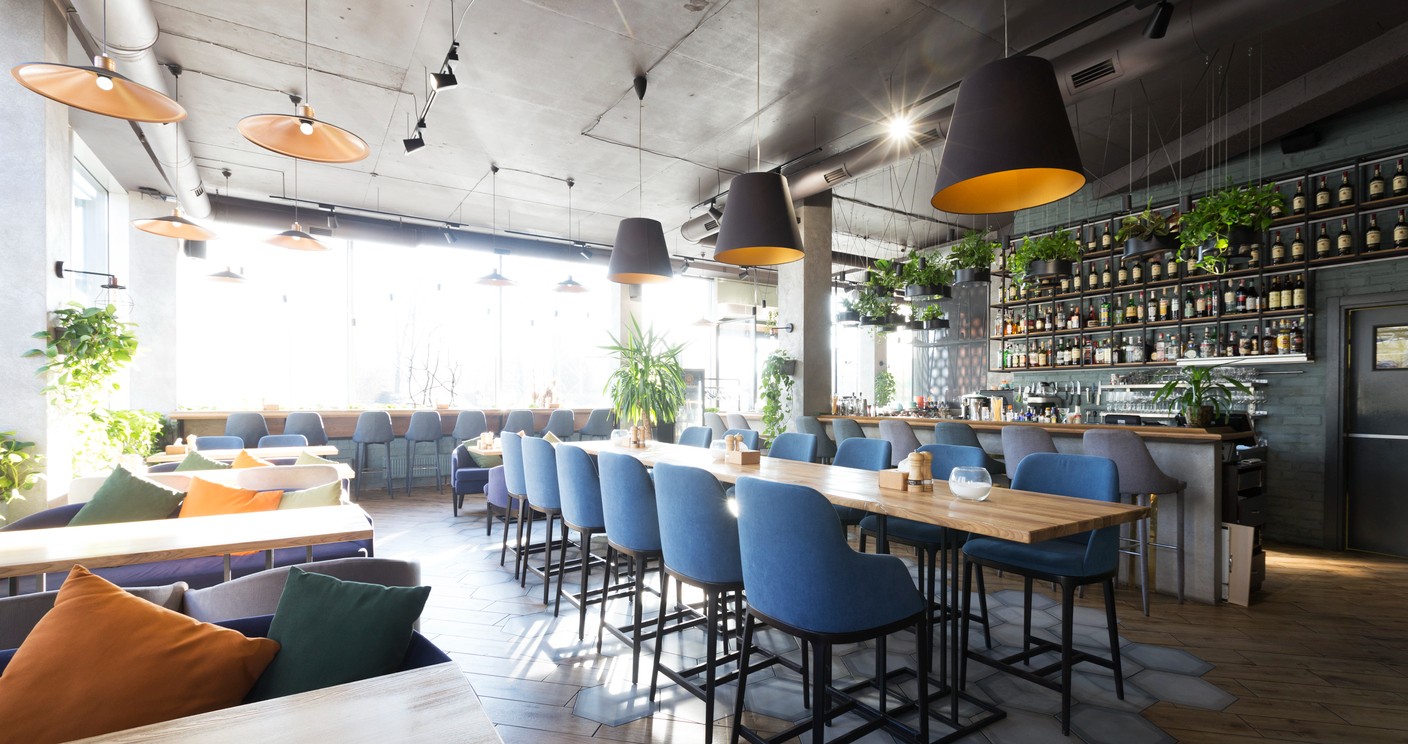Barstools play a bigger role in restaurant design than most people think. The right stool doesn’t just fill space—it sets the tone for your guests’ experience, influences how long they stay, and reflects the personality of your brand. Whether you’re outfitting a lively bar, a fast-casual concept, or a high-end dining room with counter seating, the barstools you choose have a direct impact on both atmosphere and performance.
So what type of barstool should you choose? That depends on your seating goals, available space, and the mood you’re trying to create. From swivel to stationary, backless to upholstered, every design choice shapes how guests interact with your space.
Let’s begin by breaking down why barstools matter far more than their function—and how they can quietly influence guest behavior and business outcomes.
Why Barstools Matter in Restaurants More Than You Think
Every piece of seating in a restaurant serves a purpose—but barstools work double duty. They balance comfort with space-efficiency, ease with aesthetics, and they do it all in some of the most visible areas of your layout. Often positioned at your bar, counter, or chef’s pass, these seats aren’t just functional—they’re strategic.
Here’s why barstools deserve serious consideration:
- They set the visual tone: The bar is often the first feature guests see when entering. The right barstool instantly communicates professionalism, ambiance, and attention to detail.
- They affect guest psychology: Comfortable guests stay longer, order more, and associate your space with relaxation and hospitality. The wrong stool—too tall, too hard, too wobbly—creates subtle discomfort that encourages people to cut their visit short.
- They influence layout and service flow: Smart spacing and consistent height across stools keep your service running smoothly. Poorly chosen stools can block walkways, cause crowding, or disrupt traffic near drink service or point-of-sale areas.
In short, barstools aren’t just part of your furniture—they’re part of your strategy. Choose well, and they’ll support both your atmosphere and your bottom line.
The Main Types of Barstools—and Where They Work Best
Barstools do more than offer a place to sit—they help define flow, tone, and guest expectations in your restaurant. Each type serves a specific purpose, and knowing how they function in different environments gives you a competitive edge in both form and experience.
Here’s a breakdown of the most common barstool styles and where they shine:
1.) Adjustable Barstools

- Best for: Cafés, breweries, flexible dining zones, and casual lounges
- Why they work: These stools adapt to a variety of counter heights, which is especially helpful in environments where not every surface is standard. They make seating more inclusive for guests of different sizes and offer a modern, functional aesthetic that fits well with evolving layouts. Hydraulic or screw-lift mechanisms allow easy adjustments, and many designs incorporate footrests for added comfort.
- Vibe: Casual, industrial, modern.
2.) Stationary Barstools
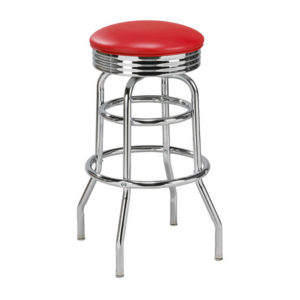
- Best for: Fine dining counters, high-end hotel bars, or chef’s tables
- Why they work: With their fixed base and sturdy frame, stationary barstools offer a sense of permanence and structure. They’re ideal in spaces where movement should be minimal—helping preserve design symmetry and maintain a clean layout. Their durability and timeless appeal make them a go-to for restaurants that prioritize longevity and refinement.
- Vibe: Sophisticated, formal, polished
3.) Swivel Barstools
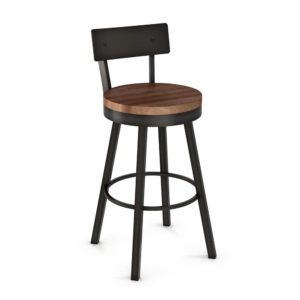
- Best for: Sports bars, fast-casual counters, or social restaurant settings
- Why they work: Swivel stools allow guests to rotate freely, making it easier to join a conversation, interact with staff, or exit the seat without disrupting others. This added functionality encourages guest engagement—key for communal and social dining settings. Look for models with smooth, quiet swivel mechanisms and stable bases for high-volume environments.
- Vibe: Relaxed, interactive, casual
4.) Backless Barstools
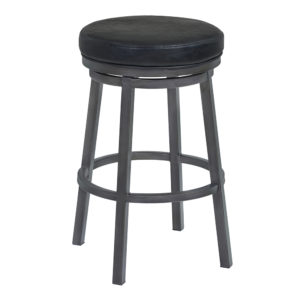
- Best for: Small spaces, coffee shops, or quick-service dining areas
- Why they work: These stools are minimal in footprint and appearance, making them ideal for tight layouts. They can slide under counters when not in use, keeping pathways open and your bar area visually clean. While they may not offer extended comfort, they’re perfect for quick visits or counter-style grab-and-go concepts where turnover is high.
- Vibe: Sleek, urban, efficient
5.) Upholstered Barstools
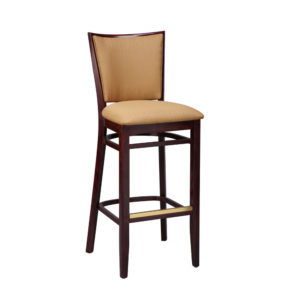
- Best for: Wine bars, boutique restaurants, or any space where guests are encouraged to linger
- Why they work: Upholstered stools provide added cushion and texture, elevating both comfort and design. They’re particularly effective in spaces where you want guests to relax, enjoy, and stay longer—helping boost per-visit spend and enhancing the overall feel of the room. Fabric or leather finishes also allow for more personalized color and branding.
- Vibe: Comfortable, refined, intimate
6.) Wood Barstools
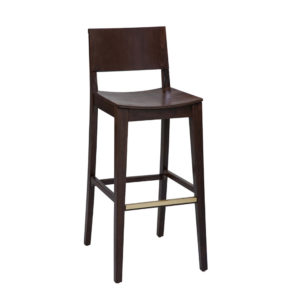
- Best for: Rustic-themed venues, farm-to-table spots, or transitional restaurant designs
- Why they work: Wooden stools bring natural warmth, solid construction, and timeless design to your layout. They pair well with a variety of materials—whether you’re mixing with metal, leather, or stone finishes—and offer a sturdy seating solution that looks as good in five years as it does today. Solid wood frames with wooden legs can also be customized for stain, tone, or finish.
- Vibe: Warm, timeless, grounded
7.) Metal Barstools
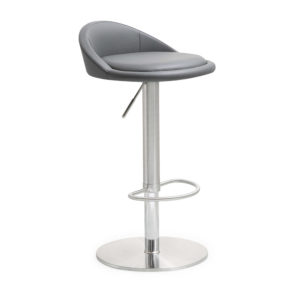
- Best for: High-volume, fast-casual concepts, outdoor patios, or industrial spaces
- Why they work: Metal stools are built for durability and easy upkeep. They’re often stackable, wipe-clean, and resistant to heavy wear—perfect for restaurants where speed and turnover matter. Their sleek profiles also work well in modern designs or minimalist interiors, and they’re often priced to support larger installations.
- Vibe: Clean, contemporary, utilitarian
Selecting the right type of barstool means more than matching your decor—it’s about understanding how form supports function, and how seating choices subtly guide the way your guests move, sit, and experience your restaurant. Check out the collection at California Dining & Barstools here.
Getting Height and Spacing Right
Barstool height isn’t just a number—it’s a critical element in creating a comfortable, functional dining environment. Choosing the wrong height can throw off ergonomics, frustrate guests, and make your layout feel cramped or awkward. That’s why understanding the difference between bar height and counter height is essential.
Bar height stools are typically 28 to 32 inches from floor to seat and are designed to pair with bar tops around 40 to 42 inches high. These are commonly used in restaurant bars, high-top communal tables, or pub-style counters.
Counter height stools sit lower—usually 24 to 27 inches high—and work best with surfaces around 36 inches tall. These are great for cafés, quick-service restaurants, and lower counter-style seating zones.
Beyond getting the numbers right, spacing between stools is just as important. Here are a few quick-reference tips:
- Leave 26–30 inches between the centers of each stool to give guests room to sit and move comfortably.
- Allow 6–10 inches between the edge of the stool and the edge of any walls or fixed furniture.
- Avoid overpacking the bar—tight seating feels uncomfortable and can negatively impact service flow.
When stools are spaced properly and the height matches the surface, guests are more likely to feel relaxed—and that sense of ease leads to longer visits, more orders, and better overall reviews. It’s a detail that affects everything from turnover rates to brand perception, and yet it’s often overlooked. The right fit doesn’t just look better—it performs better.
Matching Your Barstools to Your Restaurant’s Concept
Your barstools don’t just fill a space—they speak for your brand. The material, silhouette, and finish of each stool quietly signal what kind of experience a guest can expect. A sleek, all-metal frame suggests speed and efficiency. A plush upholstered seat with a high back implies comfort, conversation, and time well spent.
This is where design meets strategy. A barstool that looks great in one setting might feel out of place in another. Matching your stools to your concept helps build consistency across your space and supports the mood you’re trying to create. Whether you’re aiming for laid-back and approachable or elevated and refined, seating plays a crucial supporting role.
Here’s a quick look at how style, tone, and layout come together:
- Fast-casual and high-traffic venues benefit from cleanable, stackable metal stools with durable finishes and backless options to save space.
- Craft cocktail bars or boutique restaurants often lean into materials like leather, wood, and upholstery to evoke a sense of richness and refinement.
- Rustic or farmhouse-style venues find consistency with wooden stools—especially those that feature natural finishes and visible grain patterns.
- Minimalist or modern restaurants might favor low-profile silhouettes, matte finishes, and stools with sleek, geometric lines.
The goal is simple: your stools should look and feel like they belong. When every seat complements the broader design story, guests experience a more cohesive space—and that translates into comfort, brand loyalty, and stronger word-of-mouth.
Why Comfort Is Non-Negotiable
In restaurants, comfort isn’t a luxury—it’s a strategy. While aesthetics draw people in, comfort is what keeps them seated, ordering, and coming back. It influences dwell time, affects customer satisfaction, and ultimately plays a direct role in your bottom line.
Guests seated on stiff, poorly proportioned barstools tend to wrap up quickly. They might skip dessert, pass on another round, or avoid returning altogether. But when a barstool supports the body properly—with the right seat depth, footrest placement, and cushion—people stay longer, order more, and feel more at ease.
Here’s what to prioritize when evaluating barstool comfort:
- Seat width and depth: A comfortable stool should provide enough space for natural sitting posture, typically 15–18 inches wide.
- Footrests: These reduce leg fatigue and support posture, especially important for bar height stools.
- Back support: High-back or mid-back stools provide added comfort for longer stays, ideal in lounges or bars where guests linger.
- Padding and materials: Upholstery, contoured seats, and subtle cushioning go a long way—particularly in restaurants where ambiance matters.
You don’t have to sacrifice style to offer a better guest experience. In fact, the best commercial barstools blend form and function so well that the comfort goes unnoticed—because it just feels right. And when guests feel good, they stay longer, spend more, and associate that feeling with your brand. That’s not just good design—that’s smart business.
Find the Right Fit for Your Restaurant Today
At California Dining & Barstools, we specialize in helping restaurant owners like you make seating decisions that support both your space and your service.
Whether you’re furnishing a new concept or refreshing an existing layout, our showroom experts can guide you through styles, finishes, and features that align with your needs.
Stop by our Sunnyvale showroom to explore our full collection in person—or connect with us to start planning your space. The right barstools don’t just look good—they work hard for your business. Let’s find the ones that fit.
